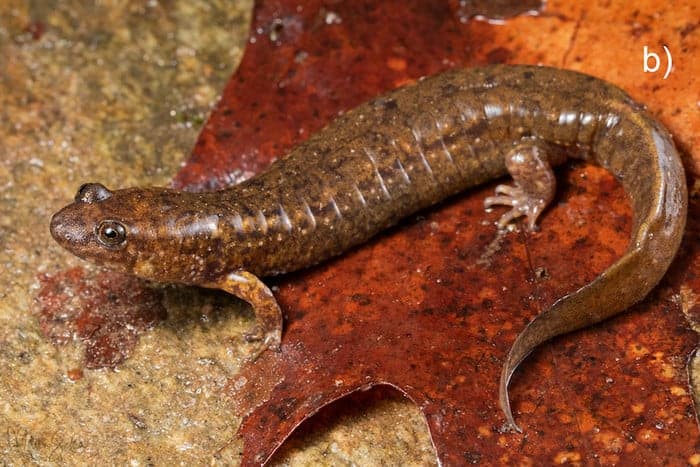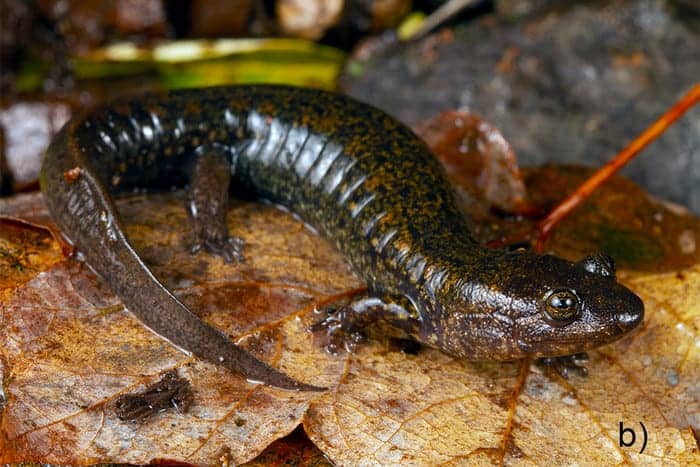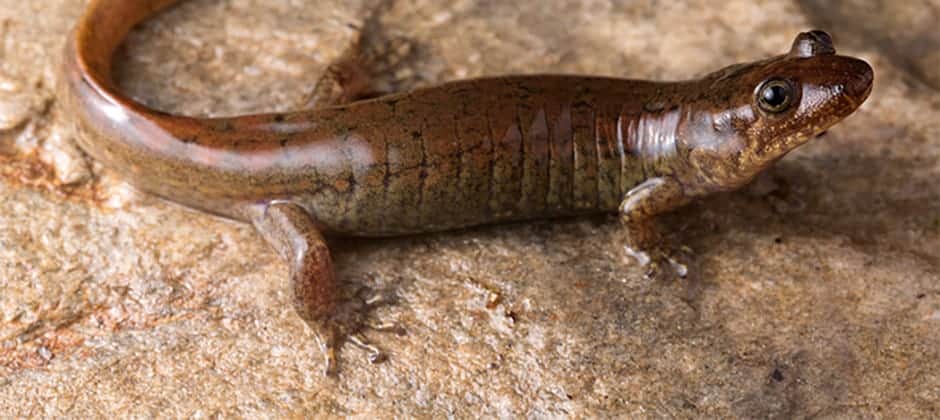Share this article
Wild Cam: A cryptic quest to describe new salamander species
Alexander Pyron carefully extracted the salamander specimens from preservation jars he kept in a steel cabinet in his laboratory at George Washington University with a set of tweezers. He laid five stiffened amphibians out on a steel tray one by one after closely reading the identification tags attached to their abdomens. The first one was a dark gray to black color with a brownish orange-mottled head. The second one was dark gray and black with a brownish orange-mottled head, a little smaller than the first. The third was dark gray all the way through, and from its head to the tip of its tail, it measured nearly three times as long as the second one and much thicker around the middle than both. To the untrained eye, the last two of the five looked basically like the first one—dark grey and black with brownish orange-mottled heads. They also appeared nearly the same size as the first one.

Credit: Joshua Rapp Learn
As of a few years ago, biologists considered four of these salamanders the same species—the blackbelly salamander (Desmognathus quadramaculatus). But new research has revealed that, even though they evolved to look similar to one another over millions of years, each of these five salamanders belong to unique species split into two separate groups.
In fact, this research is just part of a larger project Pyron and others are conducting to sort out the whole world of dusky salamanders (Desmognathus).
“These guys are equally as complex as, say, Darwin’s finches, and probably had as many interesting ecological and evolutionary processes going on,” said Pyron, an associate professor of biology at the George Washington University. “We’re just way behind the level of baseline natural history knowledge that’s required to make it a viable thing to investigate.”

Credit: Max Seldes, University of Georgia
Plethodontid or lungless salamanders, the group that dusky salamanders like the D. mavrokoilius seen above belong to, are found across the Americas, in some parts of Europe, and even in the Korean Peninsula. Dusky salamanders are only found in the eastern forests of North America. It’s likely that the species around today descended from a Plethodontid that occupied a certain climate niche across the globe. They were separated when the continents divided. Somewhere along the line, lungless salamanders evolved, losing the tadpole-like larval stage that most amphibians still have today. Most lungless salamanders hatch from their eggs as miniature versions of their future adult forms.
To confuse matters, most dusky salamanders have re-evolved the characteristic of taking on a different larval form more like tadpoles. And then to further confuse things, some of the species can successfully hybridize. In fact, some of the species that Pyron believes may be undescribed to science could in fact be the result of ancient hybrids that successfully bred with other hybrids to make a very mixed offspring that acted like a new species.
“It’s basically like if you mixed a gorilla, an orangutan and a chimpanzee, and got whatever hybrid would result from that,” he said.

Credit: Joshua Rapp Learn
Pyron was mostly studying snakes when he tuned into the world of dusky salamanders. In 2010, he came across a poster presentation by Dave Beamer, a biologist at Nash Community College in North Carolina, on the amphibians at a conference. Beamer’s research showed that while only 20 or so species of dusky salamanders were described at the time, there was likely a huge amount of hidden speciation within those described—some 47 different species probably.
The National Science Foundation awarded Beamer and Pyron a grant in 2016 to sort out the dusky salamander conundrum. With that money, they sequenced the whole genome of Desmognathus species, discovering that there were likely between 47 and 49 species.

Credit: Joshua Rapp Learn
Many dusky salamander specimens sit in vials in cabinets in Pyron’s lab. They’re either inside small jars that carry one individual or larger jars that carry several—Pyron is short on jars due to pandemic-related production issues. Others, he’s already sent off to the Smithsonian National Museum of Natural History, where there are better resources to take care of so many specimens. As he goes through vials of dozens of blackish-grey specimens that all appear similar, he explains that many of the dull yellow, reddish or orange speckles visible on the various specimens are a lot brighter when the species are still alive—one of the byproducts of the preservation fluid is a dulling of colors.

Todd Pierson, Kennesaw State University
This is true of the three new species he described recently in a study published in Bionomina. D. gvnigeusgwotli, taken from the Cherokee name for black belly and found in the Great Smoky Mountains in Tennessee and North Carolina; D. kanawha, named after the river near where it is found in Virginia and West Virginia and pictured above; and D. mavrokoilius, a name which is taken from the Greek for black belly, found around Asheville, N.C.
But there were also two others that had been initially categorized as blackbelly salamanders. The largest one that Pyron has ever seen sits on the tray in front of us—it was originally described in the 1940s but was then later treated as if it wasn’t a separate species—D. amphileucus. Another one was also described by scientists in the 1990s and given a name in 2002—D. folkertsi.
“They all have very similar blackbelly morphology,” Pyron said, pointing out small differences in the shape of body parts and color patterning. “But when we look at them very closely, we find very subtle differences.”
The effort to sort all of these dusky salamanders out has conservation implications. Salamanders—like many wetland species—suffer from stream pollution issues related to mining in Appalachia. Climate change is also a potential issue, as is the accumulation of pesticides in some areas, Pyron said.
In the Southeast, the disappearance of the longleaf pine ecosystem and the loss of habitat to development all over the place has caused a huge drop in dusky salamander numbers.
“The biodiversity loss in the southeastern plain has been massive,” Pyron said.
No U.S. dusky species are listed on the Endangered Species Act, but Pyron said there is at least one potential candidate for listing—the Holbrook’s southern dusky salamander (D. auriculatus). But its disappearance is a complete mystery.

Credit: Joshua Rapp Learn
As recently as the early 1970s, “you could find them in ditches on the side of town,” Pyron said. “You could find them at night when it was raining, just walking on the road they were so abundant.”
In roughly 1972, huge numbers of these salamanders disappeared, even from pristine-like habitats in protected areas. “It was literally overnight—they were just gone,” Pyron said. Biologists ran a number of tests, but they couldn’t tell what was wrong. It was before the spread of the chytrid fungus, and many of the populations that disappeared weren’t around agricultural areas where pesticides may have played a role. It’s possible that a pathogen was to blame, but other closely related species that lived in these areas too didn’t experience the same kind of declines.
Many other salamander species only exist in very small ranges, making them vulnerable to local conditions and problems that could have a large effect on the species as well.
The truth is that biologists still don’t know much about many of these salamanders. Questions like what they eat, what conditions they prefer and what wildlife might eat them for example. Pyron is still just wrapped up in the first step of determining what’s what—laying the ground work so that he or others can begin to study their natural history, for example.

Credit: Joshua Rapp Learn
So far, only 32 of the 47 species have been described. But Pyron and his colleagues are close to finishing the work of separating out the remaining 27—he has a few more studies in various states of readiness.
Even when those studies are complete, his work still may not be done.
“I’m always hoping I’ll flip a rock and find something totally new,” he said.
Header Image: Desmognathus gvnigeusgwotli can be among the biggest of blackbelly salamanders. Credit: Todd Pierson, Kennesaw State University








